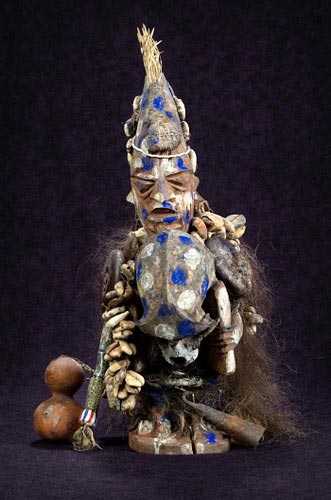Shapona, the Yoruba god of smallpox

This is a statue of Shapona, the West African God of Smallpox. Gift of Rafe and Ilze Henderson, 1995.014, CDCM Collection
Perhaps the most iconic object in the David J. Sencer CDC Museum is Shapona, the Yoruba god of smallpox. It represents the international effort to eradicate smallpox in the 1960s and 1970s.
One of four in the CDC Museum collection, this Shapona is on display. The figure was commissioned along with several others in 1969 from a fetisheur from Abeokuta (near Lagos) shortly before the May Inter-regional Seminar on Smallpox Eradication held in Lagos.
It is a unique carved wooden figure upon which are layered meaningful objects such as monkey skulls, cowrie shells, and fur. Yoruba legend held that the supreme god delegated authority over various kingdoms of the world to his two sons. To his second born son, Shango, he gave control of the sky ; but to his eldest, Shapona, he gave control of the earth, who nourished man by giving him all the grains of the earth, but when he punished, he caused those grains men had eaten to come out on their skins (Challenor 1971, 57-59). Thus, smallpox was an indication of divine displeasure. Formal worship of Shapona was highly controlled by specific priests in charge of shrines to the god. People believed that if angered, the priests were believed capable of causing smallpox outbreaks themselves. Although the British colonial rulers banned the worship of Shapona in 1907 because they suspected the priests of deliberately spreading smallpox, the god continued to be worshipped.
In the 1960s and 1970s, WHO and CDC vaccination teams in Dahomey, Togo, and western Nigeria encountered some cultural resistance from Shapona worshippers who thought they were being asked to make war on one of their own deities. Ultimately, these cultural challenges were met and overcome in this part of Africa as well as other parts of the world. Don Millar, Director of the Smallpox Eradication Program, wrote in a 1969 memo to Smallpox Eradication Program personnel, "Immediately after Christmas, George Lythcott came in for two days of consultation, bearing with him a gift of great import from Rafe and Ilze Henderson – an authentic Soponna [sic] fetish of the Babaligbo cult of Aebokuta, Western Nigeria. Rafe's comment which accompanied the fetish, 'In hopes this will soon be a relic of the past'." Eleven years later, in 1980, the World Health Organization officially declared smallpox eradicated.
- Page last reviewed: June 18, 2014
- Page last updated: June 18, 2014
- Content Source:
- Centers for Disease Control and Prevention
- Page maintained by: Office of the Associate Director for Communication, Division of Public Affairs


 ShareCompartir
ShareCompartir